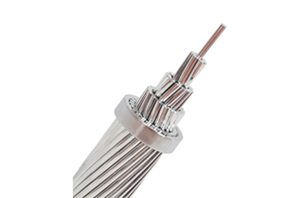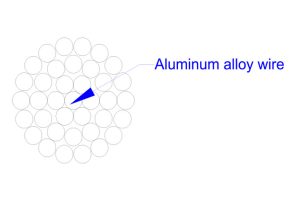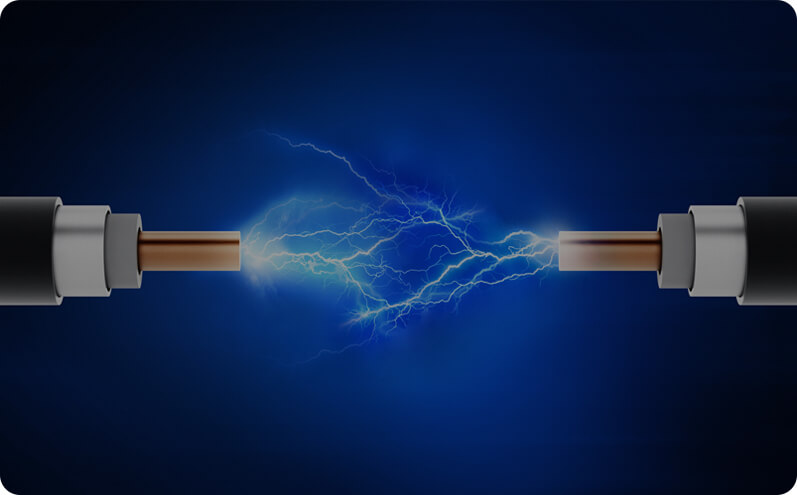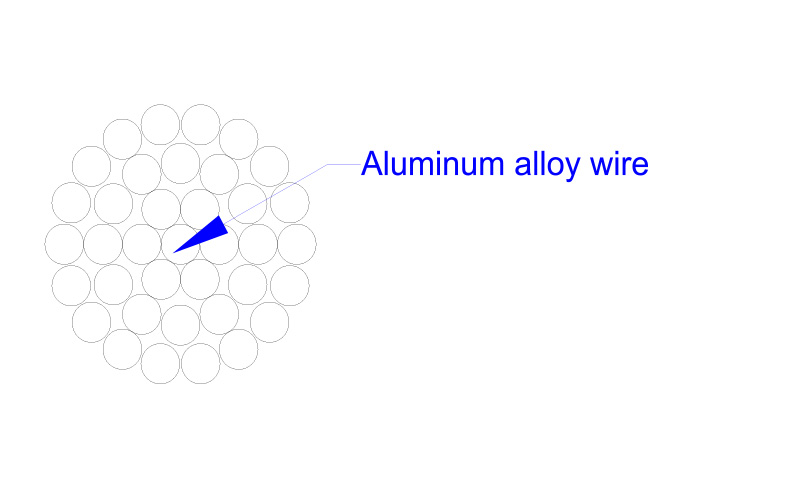



Table 1 AAAC(Characteristics of A2 Conductor ) IEC 61089
| Code Name | Calculated Area | Number of Wire | Diameter | Weight | Rated Strength | Max.D.C. Resistance at 20℃ | |
| Wire | Cond. | ||||||
| mm² | mm | mm | kg/km | KN | ohm/km | ||
| 16 | 18.4 | 7 | 1.83 | 5.49 | 50.4 | 5.43 | 1.7896 |
| 25 | 28.8 | 7 | 2.29 | 6.86 | 78.7 | 8.49 | 1.1453 |
| 40 | 46 | 7 | 2.89 | 8.68 | 125.9 | 13.58 | 0.7158 |
| 63 | 72.5 | 7 | 3.63 | 10.90 | 198.3 | 21.39 | 0.4545 |
| 100 | 115 | 19 | 2.78 | 13.90 | 316.3 | 33.95 | 0.2877 |
| 125 | 144 | 19 | 3.10 | 15.50 | 395.4 | 42.44 | 0.2302 |
| 160 | 184 | 19 | 3.51 | 17.60 | 506.1 | 54.32 | 0.1798 |
| 200 | 230 | 19 | 3.93 | 19.60 | 632.7 | 67.91 | 0.1439 |
| 250 | 288 | 19 | 4.93 | 22.00 | 790.8 | 84.88 | 0.1151 |
| 315 | 363 | 37 | 3.53 | 24.70 | 998.9 | 106.95 | 0.0916 |
| 400 | 460 | 37 | 3.98 | 27.90 | 1268.4 | 135.81 | 0.0721 |
| 450 | 518 | 37 | 4.22 | 29.60 | 1426.9 | 152.79 | 0.0641 |
| 500 | 575 | 37 | 4.45 | 31.20 | 1585.5 | 169.76 | 0.0577 |
| 560 | 645 | 61 | 3.67 | 33.00 | 1778.4 | 190.14 | 0.0516 |
| 630 | 725 | 61 | 3.89 | 35.00 | 2000.7 | 213.90 | 0.0458 |
| 710 | 817 | 61 | 4.13 | 37.20 | 2254.8 | 241.07 | 0.0407 |
| 800 | 921 | 61 | 4.38 | 39.50 | 2540.6 | 271.62 | 0.0361 |
| 900 | 1036 | 91 | 3.81 | 41.80 | 2861.1 | 305.58 | 0.0321 |
| 1000 | 1151 | 91 | 4.01 | 44.10 | 3179.0 | 339.53 | 0.0289 |
| 1120 | 1289 | 91 | 4.25 | 46.70 | 3560.5 | 380.27 | 0.0258 |
| 1250 | 1439 | 91 | 4.49 | 49.40 | 3973.7 | 424.41 | 0.0231 |
Table 2 AAAC(Characteristics of A3 Conductor ) IEC 61089
| Code Name | Calculated Area | Number of Wire | Diameter | Weight | Rated Strength | Max.D.C. Resistance at 20℃ | |
| Wire | Cond. | ||||||
| mm² | mm | mm | kg/km | kn | ohm/km | ||
| 16 | 18.6 | 7 | 1.84 | 5.52 | 50.8 | 6.04 | 1.7896 |
| 25 | 29 | 7 | 2.30 | 6.90 | 79.5 | 9.44 | 1.1453 |
| 40 | 46.5 | 7 | 2.91 | 8.72 | 127.1 | 15.10 | 0.7158 |
| 63 | 73.2 | 7 | 3.65 | 10.90 | 200.2 | 23.06 | 0.4545 |
| 100 | 116 | 19 | 2.79 | 14.00 | 319.3 | 37.76 | 0.2877 |
| 125 | 145 | 19 | 2.12 | 15.60 | 399.2 | 47.20 | 0.2302 |
| 160 | 186 | 19 | 3.53 | 17.60 | 511.0 | 58.56 | 0.1798 |
| 200 | 232 | 19 | 3.95 | 19.70 | 638.7 | 73.20 | 0.1439 |
| 250 | 390 | 19 | 4.41 | 23.10 | 798.4 | 91.50 | 0.1151 |
| 315 | 366 | 37 | 3.55 | 24.80 | 1008.4 | 115.29 | 0.0916 |
| 400 | 465 | 37 | 4.00 | 28.00 | 1280.5 | 146.40 | 0.0721 |
| 450 | 523 | 37 | 4.24 | 29.70 | 1440.5 | 164.70 | 0.0641 |
| 500 | 581 | 37 | 4.47 | 31.30 | 1600.6 | 183.00 | 0.0577 |
| 560 | 651 | 61 | 3.69 | 33.20 | 1795.3 | 204.96 | 0.0516 |
| 630 | 732 | 61 | 3.91 | 35.20 | 2019.8 | 230.58 | 0.0458 |
| 710 | 825 | 61 | 4.15 | 37.30 | 2276.2 | 259.86 | 0.0407 |
| 800 | 930 | 61 | 4.40 | 39.60 | 2564.8 | 292.80 | 0.0361 |
| 900 | 1046 | 91 | 3.83 | 42.10 | 2888.3 | 320.40 | 0.0321 |
| 1000 | 1162 | 91 | 4.03 | 44.40 | 3209.3 | 366.00 | 0.0289 |
| 1120 | 1301 | 91 | 4.27 | 46.90 | 3954.4 | 409.92 | 0.0258 |
Table 3 ASTM B399
| Area | Stranding and Wire Diameter | Approx overall Diameter | Weight | Nomianl Breaking Load | Max.D.C .Resisitance at 20℃ | |
| Nominal | Actual | |||||
| AWG or MCM | mm2 | mm | mm | kg/km | kN | Ω/km |
| 6 | 13.3 | 7/1.554 | 4.67 | 37 | 4.22 | 2.5199 |
| 4 | 21.15 | 7/1.961 | 5.89 | 58 | 6.71 | 1.5824 |
| 2 | 33.63 | 7/2.474 | 7.42 | 93 | 10.68 | 0.9942 |
| 1/0 | 53.48 | 7/3.119 | 9.36 | 148 | 16.97 | 0.6256 |
| 2/0 | 67.42 | 7/3.503 | 10.51 | 186 | 20.52 | 0.4959 |
| 3/0 | 85.03 | 7/3.932 | 11.8 | 234 | 25.86 | 0.3936 |
| 4/0 | 107.23 | 7/4.417 | 13.26 | 296 | 32.63 | 0.3119 |
| 250 | 126.66 | 19/2.913 | 14.57 | 349 | 38.93 | 0.2642 |
| 300 | 152.1 | 19/3.193 | 15.97 | 419 | 46.77 | 0.2199 |
| 350 | 177.35 | 19/3.447 | 17.24 | 489 | 52.25 | 0.1887 |
| 400 | 202.71 | 19/3.686 | 18.43 | 559 | 59.74 | 0.165 |
| 450 | 228 | 19/3.909 | 19.55 | 629 | 67.19 | 0.1467 |
| 500 | 253.35 | 19/4.120 | 20.6 | 698 | 74.64 | 0.1321 |
| 550 | 278.6 | 37/3.096 | 21.67 | 768 | 83.8 | 0.1202 |
| 600 | 303.8 | 37/3.233 | 22.63 | 838 | 91.38 | 0.1102 |
| 650 | 329.25 | 37/3.366 | 23.56 | 908 | 97.94 | 0.1016 |
| 700 | 354.55 | 37/3.493 | 24.45 | 978 | 102.2 | 0.0944 |
| 750 | 380.2 | 37/3.617 | 25.32 | 1049 | 109.6 | 0.088 |
| 800 | 405.15 | 37/3.734 | 26.14 | 1117 | 116.8 | 0.0826 |
| 900 | 456.16 | 37/3.962 | 27.73 | 1258 | 131.5 | 0.0733 |
| 1000 | 506.71 | 37/4.176 | 29.23 | 1399 | 146.1 | 0.066 |
Table 4 BS EN 50183
| Code Name | Calculated Area | Number of Wire | Diameter | Weight | Rated Strength | Max.D.C. Resistance at 20℃ | |
| Wire | Cond. | ||||||
| mm² | mm | mm | kg/km | KN | ohm/km | ||
| Box | 18.8 | 7 | 1.85 | 5.55 | 51.4 | 5.55 | 1.748 |
| Acacia | 23.8 | 7 | 2.08 | 6.24 | 64.9 | 7.02 | 1.3828 |
| Almond | 30.1 | 7 | 2.34 | 7.02 | 82.2 | 8.88 | 1.0926 |
| Cedar | 35.7 | 7 | 2.54 | 7.62 | 96.8 | 10.46 | 0.9273 |
| Deodar | 42.2 | 7 | 2.77 | 8.31 | 115.2 | 12.44 | 0.7797 |
| Fir | 47.8 | 7 | 2.95 | 8.85 | 130.6 | 14.11 | 0.6875 |
| Hazel | 59.9 | 7 | 3.30 | 9.90 | 163.4 | 17.66 | 0.5494 |
| Pine | 71.6 | 7 | 3.61 | 10.80 | 195.6 | 21.14 | 0.4591 |
| Holly | 84.1 | 7 | 3.91 | 11.70 | 229.5 | 24.79 | 0.3913 |
| Willow | 89.7 | 7 | 4.04 | 12.10 | 245.0 | 26.47 | 0.3665 |
| Oak | 118.9 | 7 | 4.65 | 14.00 | 324.5 | 35.07 | 0.2767 |
| Mulberry | 150.9 | 19 | 3.18 | 15.90 | 414.3 | 44.52 | 0.2192 |
| Ash | 180.7 | 19 | 3.48 | 17.40 | 496.1 | 53.31 | 0.183 |
| Elm | 211.0 | 19 | 3.76 | 18.80 | 579.2 | 62.24 | 0.1568 |
| Poplar | 239.4 | 37 | 2.87 | 20.10 | 659.4 | 70.61 | 0.1387 |
| Sycamore | 303.2 | 37 | 3.23 | 22.60 | 835.2 | 89.40 | 0.1095 |
| Upas | 361.1 | 37 | 3.53 | 24.70 | 997.5 | 106.82 | 0.0917 |
| Yew | 479.0 | 37 | 4.06 | 28.40 | 1319.6 | 141.31 | 0.0693 |
| Totara | 498.1 | 37 | 4.24 | 29.00 | 1372.1 | 146.93 | 0.0666 |
| Rubus | 596.9 | 61 | 3.50 | 31.50 | 1622.0 | 173.13 | 0.0567 |
| Sorbus | 659.4 | 61 | 3.71 | 33.40 | 1822.5 | 194.53 | 0.0505 |
| Araucaria | 821.1 | 61 | 4.14 | 37.30 | 2269.4 | 242.24 | 0.0406 |
| Redwood | 996.2 | 61 | 4.56 | 41.00 | 2753.2 | 293.88 | 0.0334 |
Table 5 DIN 48201
| Code Number | Calculated Area | No.and Diameter of the Wire | Overall Diameter of Conductor | Linear Mass | Rated Strength | Max.D.C. Resistance at 20℃ |
| mm | mm² | mm | kg/km | daN | ohm/km | |
| 16 | 15.89 | 7/1.70 | 5.1 | 43 | 444 | 2.0910 |
| 25 | 24.25 | 7/2.10 | 6.3 | 66 | 677 | 1.3703 |
| 35 | 34.36 | 7/2.50 | 7.5 | 94 | 960 | 0.9669 |
| 50 | 49.48 | 7/3.00 | 9 | 135 | 1382 | 0.6714 |
| 50 | 48.35 | 19/1.80 | 9 | 133 | 1350 | 0.6905 |
| 70 | 65.81 | 19/2.10 | 10.5 | 181 | 1838 | 0.5073 |
| 95 | 93.27 | 19/2.50 | 12.5 | 256 | 2605 | 0.3579 |
| 120 | 117 | 19/2.80 | 14 | 322 | 3268 | 0.2854 |
| 150 | 147.1 | 37/2.25 | 15.75 | 405 | 4109 | 0.2274 |
| 185 | 181.6 | 37/2.50 | 17.5 | 500 | 5073 | 0.1842 |
| 240 | 242.5 | 61/2.25 | 20.25 | 669 | 6774 | 0.1383 |
| 300 | 299.4 | 61/2.50 | 22.5 | 826 | 8363 | 0.1120 |
| 400 | 400.1 | 61/2.89 | 26.01 | 1104 | 11170 | 0.0838 |
| 500 | 499.8 | 61/3.23 | 29.07 | 1379 | 13960 | 0.0671 |
| 625 | 626.2 | 91/2.96 | 32.56 | 1733 | 17490 | 0.0540 |
| 800 | 802.1 | 91/3.35 | 36.85 | 2219 | 22400 | 0.0418 |
| 1000 | 999.7 | 91/3.74 | 41.14 | 2766 | 27920 | 0.0335 |